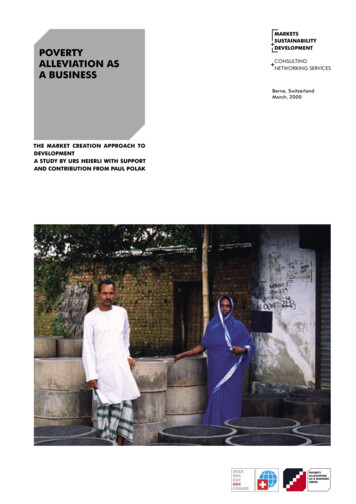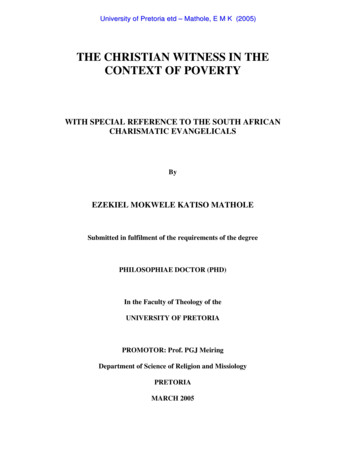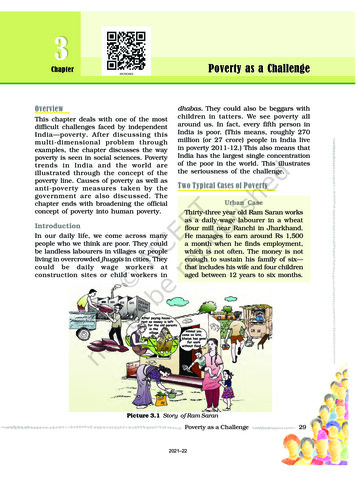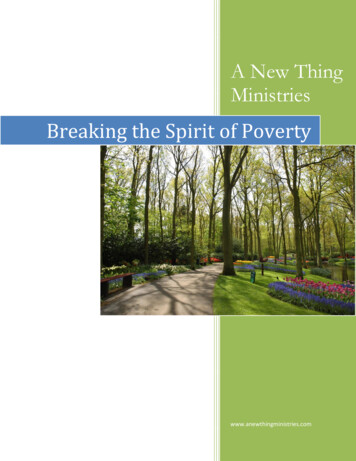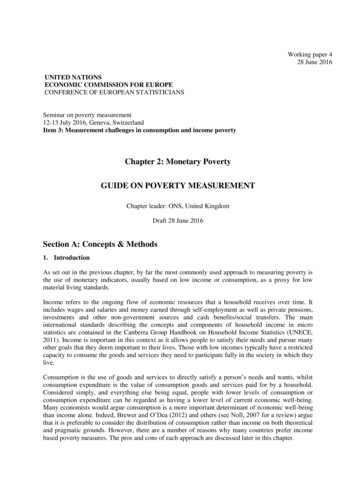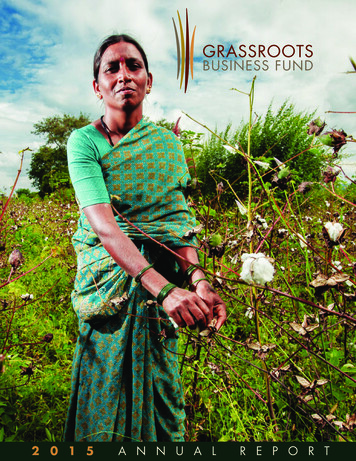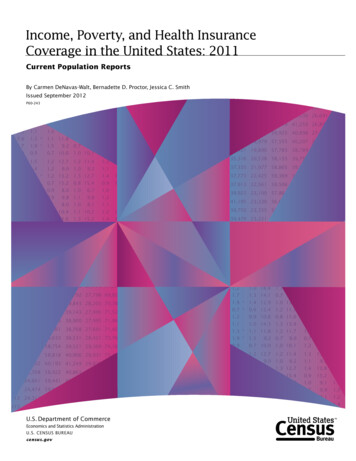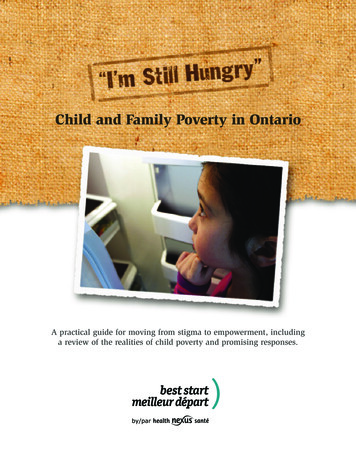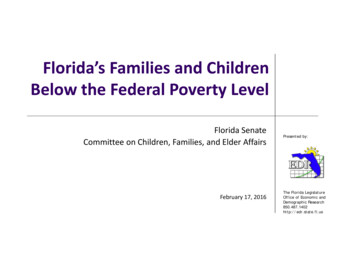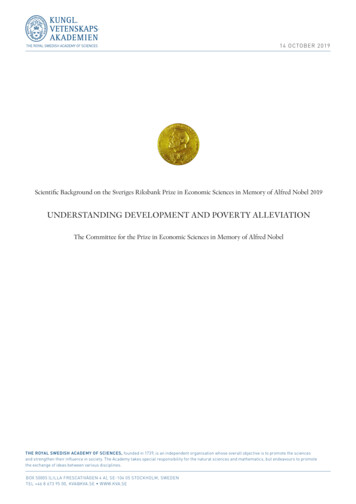
Transcription
1 4 OCTOBE R 2019Scientific Background on the Sveriges Riksbank Prize in Economic Sciences in Memory of Alfred Nobel 2019UNDERSTANDING DEVELOPMENT AND POVERTY ALLEVIATIONThe Committee for the Prize in Economic Sciences in Memory of Alfred NobelTHE ROYAL SWEDISH ACADEMY OF SCIENCES, founded in 1739, is an independent organisation whose overall objective is to promote the sciencesand strengthen their influence in society. The Academy takes special responsibility for the natural sciences and mathematics, but endeavours to promotethe exchange of ideas between various disciplines.BOX 50005 (LILLA FRESCATIVÄGEN 4 A), SE-104 05 STOCKHOLM, SWEDENTEL 46 8 673 95 00, KVA@KVA.SE WWW.KVA.SE
Scientific Background on the Sveriges Riksbank Prize in Economic Sciencesin Memory of Alfred Nobel 2019Understanding Development and Poverty AlleviationThe Committee for the Prize in Economic Sciencesin Memory of Alfred NobelOctober 14, 2019
Despite massive progress in the past few decades, global poverty — in all itsdifferent dimensions — remains a broad and entrenched problem. For example,today, more than 700 million people subsist on extremely low incomes. Every year,five million children under five die of diseases that often could have been preventedor treated by a handful of proven interventions. Today, a large majority of children inlow- and middle-income countries attend primary school, but many of them leaveschool lacking proficiency in reading, writing and mathematics. How to effectivelyreduce global poverty remains one of humankind’s most pressing questions. It is alsoone of the biggest questions facing the discipline of economics since its veryinception.So how best to identify strategies to help the least well-off? This year’s Prize inEconomic Sciences rewards the experimental approach that has transformeddevelopment economics, a field that studies the causes of global poverty and howbest to combat it. In just two decades, the pioneering work by this year’s Laureateshas turned development economics ― the field that studies what causes globalpoverty and how best to combat it ― into a blossoming, largely experimental field.Innovations both inside and outside of this field helped sow the seeds of thetransformation. Inside the field, 2015 Laureate Angus Deaton pushed the research indevelopment economics towards microeconomic analysis. He also championed theidea that the measurement of well-being, especially the well-being of the poor, mustbe closely integrated into the fight against poverty. Outside the field, the so-calledcredibility revolution, which first took off within labor economics in the early 1990s,pushed economic research in several areas towards a stronger focus on estimatingcausal effects. In addition, a well-articulated microeconomic theory appeared on howincentives and information, together with behavioral constraints, shape humanbehavior. This theory — rewarded with several Economics Prizes — gaveresearchers a powerful analytical tool kit to analyze the determinants of poverty andchannels of poverty alleviation. These methodological gains were prerequisites forthe transformation to follow, but a core piece of the puzzle was still missing.Specifically, a well-articulated theory may be crucial to discovering possiblemechanisms behind poverty and to guiding the search for effective ways to combat it.But it is not sufficient to guide policy. While theory can pinpoint certain incentives, it2
does not tell us how powerful these are in practice. To give just a few examples,theory cannot tell us whether temporarily employing additional contract teachers witha possibility of re-employment is a more cost-effective way to raise the quality ofeducation than reducing class sizes. Neither can it tell us whether microfinanceprograms effectively boost entrepreneurship among the poor. Nor does it reveal theextent to which subsidized health-care products will raise poor people’s investment intheir own health. Knowing the right quantitative answers to such specific questions isvital for enhancing human capital, increasing income, and improving health amongthe poor. Answering these questions requires an empirical approach that allowsresearchers to draw firm conclusions about causal effects.By pioneering an approach to empirical research for providing such answers, the2019 Laureates ― Abhijit Banerjee, Esther Duflo and Michael Kremer ― havetransformed development economics. Their approach remained guided bymicroeconomic theory and the use of microeconomic data. But it shifted focustowards identifying workable policies, for which one can make causal claims ofimpact.As a result, we now have a large number of concrete results on specific mechanismsbehind poverty and specific interventions to alleviate it. For example, on schooling,strong evidence now shows that the employment of contract teachers is generally acost-effective way to improve student learning, while the impact of reduced class sizeis mixed, at best. On health, poor people’s investment in preventive care has beenshown to be very sensitive to the prices of health products or services, giving astrong argument for generous subsidies to such investments. On credit, growingevidence indicates that microfinance programs do not have the development effectsthat many had thought when these programs were introduced on a large scale.The transformation of the field involved important contributions by several scholars.Three contributions by the Laureates, however, stand out.First, in the mid-1990s, Kremer and his co-authors launched a set of randomizedcontrolled trials on schooling in Kenya. 1 In effect, their approach amounted to splittingA randomized controlled trial is a method to estimate the causal impact of a certain intervention,program or policy. A field experiment is a randomized controlled trial in which participants makechoices in their normal day-to-day environment. Section 1 gives a more detailed description.13
up the question of how to boost human capital in low-income countries into smallerand more manageable specific topics, each of which could be rigorously studied via acarefully designed field experiment. Soon thereafter, Banerjee and Duflo, oftentogether with Kremer or others, broadened the set of educational topics andexpanded the scope of the research to other areas, including health, credit andagriculture.Second, in a series of contributions, Banerjee and Duflo articulated how pieces fromsuch microeconomic studies can help us get closer to solving the broad developmentpuzzle: what explains the enormous difference in per-capita income acrosscountries? They started by documenting a striking empirical fact: low- and middleincome economies encompass enormous heterogeneities in the rates of return to thesame factors of production within countries, which dwarf observed cross-countryheterogeneities in economy-wide (average) returns. In other words, some firms andindividuals in developing countries use the latest technology, while others in thesame country and sector use outdated production methods. In high-income countries,these within-sector differences in productivity are much smaller. A deeperunderstanding of the development problem thus requires an explanation of why somefirms and individuals do not take advantage of the best available opportunities andtechnologies. Banerjee and Duflo further argued that these misallocations can betraced back to various market imperfections and government failures. Hence, a corestep in understanding, and ultimately alleviating, poverty is to identify sources of theobserved inefficiencies as well as policies that could address them.Finally, by designing new experimental research methods and by addressing the keychallenge of generalizing results from a specific experiment — i.e., the issue ofexternal validity — the Laureates firmly established this transformed approach todevelopment economics. This laid a solid stepping stone for a new generation ofresearchers in development economics and other fields.In sum, by bringing the theory of incentives closer to direct applicability, the researchby the Laureates has profoundly altered the practice of development economics. Thework by the Laureates, and by many other scholars who followed in their footsteps,has dramatically increased the practical quantitative knowledge necessary to isolatekey mechanisms behind poverty and behavioral responses to various policy4
interventions. This work has significantly deepened our understanding of poverty inthe developing world.We start this overview by describing the core ideas behind the new microeconomicapproach to development economics and by discussing the key foundationalcontributions (Section 1). Then, we go on to present some of the substantiveresearch findings by the Laureates. This presentation spans several topics that helpus understand the stark welfare differences between people in high-income and lowincome countries, although they constitute only a small fraction of the Laureates’empirical contributions. It also describes how the research findings were achieved(Section 2). Next, we discuss challenges to external validity and sketch out how theLaureates and others have shown ways forward to resolve these challenges (Section3). We end by a short account of how the new experimental approach has influencedpolicy (Section 4) and concluding remarks (Section 5).1. The Experimental Approach to Alleviating Global PovertyThis section describes the cornerstones on which the modern approach todevelopment economics is built. We start by discussing the three contributionshighlighted in the introduction. Then, we briefly discuss the main empirical method:randomized controlled trials. Finally, we turn to how this method has been used.Three key contributionsThe modern approach to development economics relies on two simple but powerfulideas. One idea is that empirical micro-level studies guided by economic theory canprovide crucial insights into the design of policies for effective poverty alleviation. Theother is that the best way to draw precise conclusions about the true path fromcauses to effects is often to conduct a randomized controlled field trial. Thesystematic application of these ideas over the past 20 years has paved the way forthe transformation of development research.This revamping of the field entailed a few distinct steps, with important contributionsby several scholars. However, three contributions by the Laureates stand out.5
First, starting in the mid-1990s, Kremer and various colleagues launched a series offield experiments in Kenya to disentangle various components in the educationalproduction function (Kremer 2003). In essence, his approach amounted to breakingdown the question of how to boost human-capital accumulation into smaller, moremanageable topics, each of which could be rigorously studied via specificallydesigned randomized controlled trials. Soon thereafter, Banerjee and Duflo — inmany cases jointly with Kremer and other co-authors — broadened the set ofeducational topics and launched field experiments on several other topics. Thesestudies played a central role in expanding the new approach to basically all branchesof development economics. Moreover, the research results pointed to importantmarket inefficiencies in the private and public sectors and provided evidence onalternative ways to address these inefficiencies.Second, in a series of contributions, Banerjee and Duflo articulated the intellectualcase for a microeconomic approach to help understand various aspects of thebroader (macroeconomic) development problem (Banerjee and Duflo 2005, 2007,2011). Among these, the paper that Banerjee and Duflo published in 2005 is a keyconceptual piece that links microeconomic development issues to low aggregate percapita income in developing countries. The starting point for this work is an importantempirical observation: low- and middle-income countries have large heterogeneitiesin the rates of return to the same factors of production and large variation in theextent to which profitable investment opportunities are exploited. The extent of thismisallocation may be severe enough to help explain the large total-factor productivitygaps between low- and high-income countries that have been highlighted in theempirical growth literature. Intuitively, when resources are allocated optimally, theeconomy will operate on its production-possibilities frontier. When resources aremisallocated, the economy will operate inside this frontier: output and productivity willbe lower than they could be. Banerjee and Duflo further argued that market andgovernment imperfections documented in the development literature — be theygovernment failures, credit constraints, insurance failures, externalities, familydynamics, or behavioral issues — can help explain the misallocation. The first step tounderstanding why some countries are poor is thus to empirically identify importantsources of inefficiency and policies to address them. The book Poor Economics: ARadical Rethinking of the Way to Fight Global Poverty (Banerjee and Duflo 2011)6
takes this argument yet another step forward. Based on results from a large set ofmicrostudies on the causes of poverty, Banerjee and Duflo have drawn lessons for ascience-based approach to improving the health, schooling and incomes of the poor.Third, by designing new experimental-research methods — e.g., to address the keychallenge of external validity (Duflo 2004, 2006a, Duflo, Glennerster and Kremer2006, Banerjee and Duflo 2009) — the Laureates firmly established the newapproach and laid out a clear course forward for a new generation of researchers.The Abdul Latif Jameel Poverty Action Lab at MIT (J-PAL), which Banerjee and Duflofounded together with Sendhil Mullainathan, also was vital to this endeavor. J-PALhas promoted research built on randomized controlled trials in many countries andpromoted the acceptance of results from such trials in the economic-policycommunity. 2Estimating causal effectsAn important boost for the transformation of development-economics research wasthe creation and adoption of a (more) coherent microeconomic theoretical framework.Another important catalyst was the strong shift in other areas of economics towardsempirical studies explicitly designed to credibly estimate causal relations. This socalled design-based approach started among labor economists in the early 1990s(see the overview in Angrist and Pischke 2010). But unlike the original design-basedapproach, which relied largely on natural experiments, the new microeconomicdevelopment research relied largely, though not exclusively, on field experiments.A randomized controlled trial is a method for assessing the causal impact of a certainintervention or program. In essence, it is designed to answer counterfactualquestions: How would individuals exposed to a program have fared in the absence ofthe program? Conversely, how would other individuals who were not exposed havefared, had they had the opportunity to participate? These questions are2 Duflo, Banerjee and Mullainathan are not alone among leading development economists to linkexperimental research to policy change and advice. For example, Dean Karlan co-foundedInnovations for Poverty Action (IPA) — a nongovernmental organization (NGO) with offices in anumber of developing countries — roughly at the same time as J-PAL was founded. IPA plays acrucial role in assisting researchers to run and implement experiments throughout the world. A fewyears later, the Center for Effective Global Action Lab (CEGA) was co-founded by Edward Miguel.Duflo and Kremer co-founded Deworm the World (now part of the NGO Evidence Action) to transforminto action the evidence from the early deworming trial of Miguel and Kremer (2004).7
counterfactual because at any given point in time, an individual is either exposed tothe program or not. This is an instance of “the fundamental problem of causalinference” (Holland 1986): estimating the impact of a program on an individual at agiven time is impossible. However, it is possible to estimate the average impact of theprogram on a group of individuals by comparing them to a similar group of individualswho were not exposed to the program. 3 To do so requires a credible comparisongroup: a group of people who would have had outcomes similar to those exposed tothe program, in the absence of the program. But how does one find such a validcomparison group?If we just compare the group of individuals exposed to a program with a groupconsisting of nonexposed individuals, the estimated difference has two components.One component is the average causal effect of the program. But the estimateddifference also would include a term reflecting selection bias: the difference incounterfactual outcomes between the two groups in the absence of the program.Without a reliable way to estimate or remove this selection bias, causal effectscannot be credibly estimated.One method to solve the selection problem is to randomly assign individuals — ormore generally the units of analysis, such as households, communities or schools —to a treatment and a control group. If a unit belongs to one of these groups just as theresult of a random draw, the only systematic differences across the groups arisethrough their exposure to treatment. When correctly designed and implemented, arandomized controlled trial thus allows researchers to estimate the causal impact of acertain intervention in an unbiased way.Of course, randomized controlled trials have a long history in science. 4 A centuryago, agricultural researchers pioneered the approach in crop studies. In the postwarera, randomized controlled trials became closely associated with clinical trials andlater field trials in medicine. In economics, some important randomized controlledtrials predate the explosion of experimental work in development economics,including the negative income-tax experiments (Hausman and Wise 1985), the RANDHealth Insurance Experiment (Newhouse 1993), a series of welfare reformSimilarly, one can estimate the impact on other moments of the distribution than the mean.The earliest published description of a clinical trial appears to be James Lind's test in 1747 of thevalue of oranges and lemons in treating scurvy in sailors. For details, see Thomas (1997).348
experiments in the 1980s and 1990s (Manski and Garfinkel 1992), and educationalresearch, such as the Perry Preschool Project and Project STAR (Schweinhart,Barnes and Weikart 1993). Thus, the main method used to estimate causal effects isnot new. But, as we describe next, the application of randomized controlled trials indevelopment economics has significantly expanded its use. 5Quantifying causal pathwaysThe approach championed by the Laureates rests on a fundamental insight ofeconomics: most outcomes one may want to influence reflect purposeful choicesmade by individuals. To sustainably influence the outcomes of interest, also calledendpoints, one must therefore understand the choices that drive observed outcomes,as well as the mechanisms that mediate those choices. That is, one needs to pinpointthe causal pathways through which changes in incentives, constraints andinformation influence outcomes of interest via human behavior.For example, the knowledge to stop life-threatening afflictions of malaria, diarrhea,tuberculosis and other deadly diseases has largely been gathered throughrandomized controlled trials conducted by medical researchers. Despite thisestablished medical knowledge, millions of children in low-income countries die frompreventable diseases each year. Today’s discussion about reducing child mortality inlow-income countries therefore largely revolves around human behavior. Why isproven and inexpensive quality care not provided or demanded? Why do providers atvarious links in the service-delivery chain not show up, or not perform, at work? Howcan those hurdles be overcome? If so, how could workable services be delivered incost-effective ways? Such questions are at the heart of the experimental approachadopted by development economists.The strong emphasis on incentives and constraints is an important reason whydesigns of field experiments differ from designs in more controlled settings. Forexample, double-blind field trials are not typical, by design and for practical reasons.In the case of schools, adding additional resources can only crowd out investmentsor efforts by parents if they are aware of the additional resources (in other words, notThe use of randomized controlled trials, often referred to as field experiments, has also increased inother fields of economics (for overviews, see, e.g., Harrison and List 2004 and Card, DellaVigna andMalmendier 2011).59
blind to them). These behavioral responses are not only central to understanding theexperimental results themselves, but also to understanding broader humanbehaviors. In fact, the focus on so-called behavioral midpoints has made fieldexperiments powerful tools for more general tests of human behavior. Theresponses, and their connections to economic theory, also may shed light on broaderissues, beyond the experimental intervention at hand.Uncovering mechanismsThe quest to uncover mechanisms also helps explain why field experiments havebecome the dominant empirical method in the field. Randomized controlled trials areunique in giving researchers complete control not only over the assignmentmechanism, which removes the selection bias, but also over the treatment itself. AsDuflo and Banerjee emphasized (Duflo 2006a, Banerjee and Duflo 2009),conventional observational studies evaluate events that have already occurred in theworld. Experiments allow scholars to manipulate treatments of interest to createevents that have not yet been observed.This design flexibility has a number of advantages. Researchers can test newpolicies or interventions they believe might be effective, based on prior knowledge ortheory, even if no policymaker is currently considering implementing them. Moreover,they can introduce random variation to test predictions from existing theory. 6Furthermore, experiments allow for a transparent iterative research process in thesame setting, with the same outcome variables and the same measurementtechniques. Whether by quasi-experimental or fully experimental methods, empiricalwork typically raises important follow-up questions. But follow-ups in observationalstudies are limited by the original policy change that generated the initial data. Theability to control the treatment itself relaxes that constraint and enables researchersto learn from sequential multistep experiments, where each new step takes6 The ability to design new interventions — in many cases by revising, amending or decomposingprograms run by others, e.g., NGOs — separates the development literature from the evaluation(social-experiment) literature in the US and Canada (see Gueron 2017 for a discussion). In the latter,the programs to be evaluated are typically fairly comprehensive packages chosen by an implementingagency with the researchers primarily serving as professional evaluators. Notable exceptions includethe research-led Negative Income Tax (NIT) experiment and the RAND Health Insurance Experiment,which were both designed to test mechanisms (income and substitution effect in the NIT experiments,and moral hazard in the Rand Health Insurance Experiment).10
advantage of the results in earlier steps. As noted by Duflo (2006a), such learning ina fixed context and with a fixed population is usually associated with laboratoryexperiments. Unlike most laboratory experiments in other areas of economics,however, field experiments in development economics involve real-world decisionmakers who make important choices in their normal day-to-day environment.Finally, as discussed by Kremer and Glennerster (2011), planning and implementingfield experiments forces researchers to engage and spend time with realities on theground, often working closely with government or nongovernment agencies. Thisfield-based approach allows for an inductive discovery of new mechanisms and facts,beyond those suggested by existing models. This induction, in turn, can help refinethe theory and improve our ability to design better policies.2. Evidence on Fighting Poverty in Developing CountriesThis section traces the intellectual history of the experimental approach indevelopment economics, focusing on a set of thematic areas: education, health,behavioral biases, gender and politics, and credit. A separate subsection for each ofthese five areas highlights the substantive contributions by the Laureates.The following is by no means an exhaustive presentation of the Laureates’ research,and even less a literature review of the five thematic areas. However, it elucidateshow the experimental approach pioneered by Banerjee, Duflo and Kremer hassubstantially changed our factual knowledge about economic, social and politicalphenomena in developing countries, as well as the methodological direction of thefield. It also illustrates the broad approach to poverty alleviation taken in the field,ranging from policies to boost human and physical capital accumulation, via policiesaimed at facilitating adoption of better technologies, to interventions that caninfluence how policies affecting the poor are chosen and implemented. Moreover, alarge set of well-identified microeconomic studies by many researchers have beenconducted in most areas of development. To reemphasize a point from theintroduction, the Laureates’ research has transformed the field through theexperimental approach they pioneered.11
2A. EducationThe macroeconomic research on growth and development in the late 1980s and1990s emphasized human capital, often approximated by educational attainment, intheoretical work (e.g., Lucas 1988) and empirical work (e.g., Barro 1991 and Mankiw,Romer and Weil 1992). Growth accounting attempted to decompose long-run growthacross countries into a set of proximate causes, including human capital. Thistechnique required measuring the returns to human capital, which was largely doneby running cross-sectional Mincer regressions that linked wages to educationalattainment.That empirical literature, however, suffered from three problems. First, estimatedcross-sectional returns to education were often biased because the underlyingvariation in education reflected systematic selection. Second, returns were measuredfrom years of schooling, and these are not equal across time and place in terms ofhuman-capital acquisition. Finally, the literature was largely silent on policy, i.e., howto most effectively increase enrollment and improve student learning. The newresearch pioneered by the Laureates has made important progress in all thesedimensions.Effects of better schoolingIn the mid-1990s, Kremer and his co-authors initiated the transformation ofdevelopment economics. To investigate how supply and demand factors interact todetermine educational outcomes, they launched a series of field experiments incollaboration with a nongovernmental organization (NGO) in western Kenya. Two ofthe experiments estimated the impact of additional school inputs: textbooks, startedin 1996 (Glewwe, Kremer and Moulin 2009), and flip charts, started in 1997 (Glewwe,Kremer, Moulin and Zitzewitz 2004). Two other experiments estimated the effects ofhealth interventions, including deworming of children, started in 1998 (Miguel andKremer 2004), and school meals, started in 2000 (Vermeersh and Kremer 2005).One experiment, begun in 1998, provided teachers with financial incentives tied tostudents’ test scores (Glewwe, Kremer and Moulin 2010).These early studies illustrated the power and feasibility of focused field experiments.But they also offered substantive lessons. Given the context, simply providing more12
resources had a limited impact on school quality. More textbooks per student did notimprove average test scores, but did improve test scores of the most able students.Giving flip charts to schools had no effect on student learning. The two healthinterventions reduced school absenteeism, but did not improve test scores. In theory,the incentive program could lead teachers either to increase effort to stimulate longterm learning or, alternatively, to teach to the test. The latter effect dominated.Teachers increased their efforts in test preparation, which raised test scores onexams linked to the incentives, but left test scores in unrelated exams unaffected.Matching teaching better to student-learning levelsThe findings from the first field experiments in Kenya provided a starting point for anearly randomized controlled trial regarding education in India, which started in 2000(Banerjee, Cole, Duflo and Linden 2007). Reviewing the findings from Kenya,Banerjee, Duflo and their co-authors concluded that students appeared to learnnothing from additional days at school. Neither did spending on textbooks seem toboost learning, even though the schools in Kenya lacked many essential inputs.Moreover, in the Indian context Banerjee and Duflo intended to study, many childrenappeared to learn little: in results from field tests in the city of Vadodara fewer thanone in five third-grade students could correctly answer first-grade curriculum mathtest questions. 7In response to such findings, Banerjee, Duflo and co-authors argued that efforts toget more children into school must be complemented by reforms to improve schoolquality. Additional inputs may only work when they address specific unmet needs. Inparticular, they argued that neither the pedagogy nor the curriculum had beenadapted to the large influx of children into primary education, as also suggested bythe findings reported by Glewwe, Kremer and Moulin (2009). Many of the newstudents were indeed first-generation learners, whose parents
Scientific Background on the Sveriges Riksbank Prize in Economic Sciences in Memory of Alfred Nobel 2019 . Understanding Development and Poverty Alleviation
